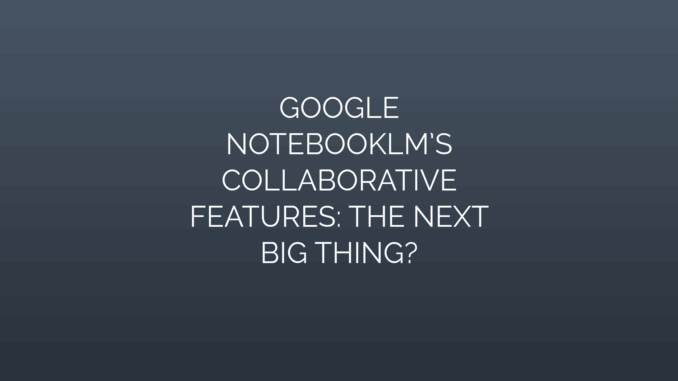
Google NotebookLM’s Collaborative Features: The Next Big Thing?
Introduction
In an era defined by information overload, tools that streamline knowledge management and team collaboration are no longer optional—they’re essential. Google NotebookLM, an AIpowered platform designed to synthesize insights from documents and conversations, entered this landscape with a reputation for personal productivity. Yet its recent pivot toward collaborative functionality has sparked industry buzz. Could these features position Google NotebookLM as the catalyst for the next evolution in teambased knowledge work? This article examines its collaborative capabilities, potential impact, and viability as a transformative solution.
What Is Google NotebookLM?
Google NotebookLM—initially launched as “Project Tailwind”—is an AIdriven notebook that integrates useruploaded sources (PDFs, Docs, text) to generate summaries, FAQs, and explanatory content. Unlike generic chatbots, it anchors responses exclusively to provided materials, enhancing accuracy and reducing hallucinations. Built on Google’s Gemini model, it analyzes data contextually, turning fragmented information into actionable insights. While early versions focused on individual researchers or writers, recent updates have strategically targeted multiuser workflows, signaling a shift toward teamcentric utility.
The Evolution of Collaboration Tools
Collaboration software has evolved rapidly:
- Phase 1: Basic document sharing (e.g., Google Docs, Dropbox).
- Phase 2: Synchronous editing with comment threads (e.g., Notion, Confluence).
- Phase 3: AI-augmented co-creation (e.g., Figma’s AI features).
Despite progress, gaps persist. Teams struggle to maintain a unified knowledge base, reconcile conflicting document versions, or quickly distill insights from large datasets. Google NotebookLM enters this space with a unique proposition: an AI “research assistant” that unifies analysis and teamwork within a single environment.
How Google NotebookLM’s Collaborative Features Work
The platform’s collaboration suite centers on three pillars:
1. Shared Notebooks Users create notebooks from uploaded files (e.g., research papers, meeting transcripts) and invite collaborators. Unlike conventional cloud storage, Google NotebookLM enables teams to:
- Pose questions collectively (e.g., “What are the key risks mentioned in these contracts?”).
- See AI-generated answers grounded in shared sources, ensuring alignment.
- Edit source materials in real-time—updates instantly refine future AI responses.
2. MultiUser AI Dialogue Collaborators participate in shared AI chat threads to:
- Debate interpretations of source content.
- Cross-reference disparate materials (e.g., linking sales data to project proposals).
- Trace responses to source citations, reducing ambiguity.
3. Dynamic Knowledge Synthesis Google NotebookLM autogenerates summaries, FAQs, and glossaries as collaborators interact. For instance:
- After uploading interview transcripts, the AI might create a “Key Themes” section.
- During team discussions, it suggests contradictions or gaps across documents.
Potential Impact on Workflows
These features could revolutionize three areas:
Research & Development Teams ingest technical documents, competitor analyses, or user feedback. Google NotebookLM identifies patterns faster, letting researchers focus on innovation rather than data wrangling.
Content Creation Writers jointly develop scripts, articles, or reports using AI to ensure tone consistency and factual alignment across contributors—cutting revision cycles.
Education & Training Instructors build interactive study guides from course materials. Students collaboratively query complex textbooks, with the AI clarifying concepts in context.
Competitive Edge: How Google NotebookLM Stands Out
Key differentiators against rivals:
- Source-Grounded AI: Unlike ChatGPT or Microsoft Copilot (which draw from broad web data), Google NotebookLM restricts answers to uploaded files, boosting trust for sensitive or specialized projects.
- Context Preservation: Google’s infrastructure enables robust source indexing, letting the AI reference specific sections across 100+ documents—surpassing free-tier alternatives like Claude or Perplexity.
- Integration Potential: As a Google product, future ties to Workspace (Gmail, Drive, Meet) seem inevitable, positioning it for seamless enterprise adoption.
Current Limitations
While promising, challenges remain:
- Limited Access: Still a U.S.-only experimental product; global rollout timeline is unclear.
- Integration Gaps: No API or deep Workspace sync yet, restricting workflow automation.
- Content Restrictions: Struggles with handwritten notes, images, or complex spreadsheets compared to tools like Otter.ai.
- Privacy Questions: Despite offline processing assurances, some enterprises remain wary of uploading proprietary data.
The Verdict: Is This the “Next Big Thing”?
Four factors suggest Google NotebookLM could redefine collaboration:
1. AI Efficiency: It reduces “knowledge friction,” letting teams analyze data faster and democratize expertise. 2. Scalability: Google’s infrastructure ensures it handles largeteam demands where startups like Mem.ai might lag. 3. Market Timing: Demand for contextaware AI tools is surging, placing it ahead of legacy platforms. 4. Strategic Positioning: Free access and Google’s ecosystem create adoption leverage.
However, success hinges on addressing limitations. Broader format support, enterprise controls, and global availability are critical. If executed well, Google NotebookLM could become the backbone for nextgen collaborative intelligence—merging human creativity with machine precision.
Conclusion
Google NotebookLM’s collaborative features represent a bold step toward AIfacilitated teamwork. By centralizing sourcebased analysis and multiuser dialogue, it targets the core pain point of modern knowledge work: connecting insights, people, and accuracy. While obstacles like accessibility and feature depth remain, its foundation—paired with Google’s resources—signals transformative potential. For businesses, researchers, and educators, this might be the tool that finally turns fragmented information into collective genius. The next big thing? Quite possibly—if it grows beyond its experimental roots.
Leave a Reply